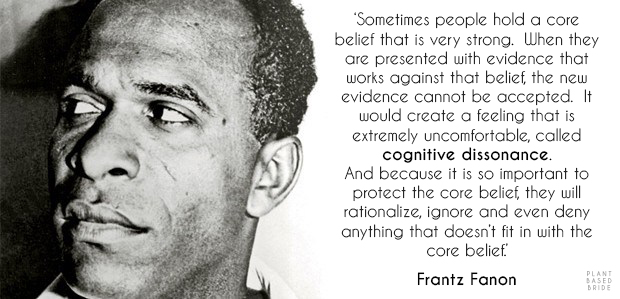What Is Cognitive Dissonance?
Cognitive dissonance is a mainstay in vegan activism, and for good reason. But what does it actually mean?
cog·ni·tive dis·so·nance
noun PSYCHOLOGY
the state of having inconsistent thoughts, beliefs, or attitudes, especially as relating to behavioural decisions and attitude change.
Essentially, cognitive dissonance is the discomfort felt by someone who holds beliefs inconsistent with their actions. A good example of this is to think of someone who believes that they are honest, but they have cheated on tests in the past. The awareness of the conflict between these two things will likely make this person uncomfortable.
Need another example? How about someone who knows that smoking causes cancer, but enjoys smoking? It is likely that this person feels discomfort at the discrepancy between their knowledge and actions.
But it's not just about discrepancies between beliefs and actions. Cognitive dissonance can also refer to the mental stress experiences by someone who holds multiple contrasting beliefs, values, or ideas simultaneously, or learns new information which conflicts with currently held beliefs, values, or ideas.
The cognitive dissonance theory was first proposed by Leon Festinger in 1957, who stated that a powerful motive to maintain cognitive consistency can give rise to irrational and sometimes maladaptive behaviour.
This is the second important aspect of cognitive dissonance: the strong drive to correct the inconsistency to relieve discomfort, no matter how 'irrational and sometimes maladaptive' the method may be.
The study that lead him to come to this conclusion? He infiltrated a cult that believed the world would end in a flood, but that they would be saved by an alien race. When the flood didn't come to pass some cult members became even more devout, believing that the aliens had in fact chosen to save the entire planet in concern for the cult members.
You can see here the need of these cult members to achieve consonance (or agreement) between held beliefs and events and the steps they took to reduce or eliminate the unpleasant feeling of dissonance.
Examples of cognitive dissonance are all around us.
Each of us has learned knew things, or experienced an event, which have conflicted with old thoughts or beliefs and led us to change. In fact, it can be the strongest motivator for change.
The dissonance we experience increases depending on how important something is to us, how much conflict there is between the thoughts/believes/actions/events, or our inability to rationalize the conflict (explain it away).
Humans dislike feeling discomfort. If they cannot ignore it, or actively avoid situations and information likely to increase it, they must take steps to reduce it by:
- changing their behaviour;
- changing their thoughts or beliefs that conflict with their behaviour;
- or adding new beliefs which justify their behaviour.
Let's look at another example of this to really understand it.
I know that the air pollution in big cities is bad for my health, and yet I live in downtown Toronto. The four methods of reducing the tension between my belief about myself (that I am health conscious) and my behaviour (that I live in a highly polluted area) are:
- Changing my behaviour (moving out of the city to a less polluted area);
- Justifying my behaviour by changing the conflicting cognition ("I'm really healthy in every other aspect of my life, so it doesn't really matter.");
- Justifying my behaviour by adding new cognitions ("I can get out of the city from time to time to breathe fresh air."), or;
- Ignoring or denying any information that conflicted with existing beliefs ("Air pollution doesn't actually have an impact on my health.").
I once saw myself as an animal lover, and yet I ate meat, dairy, and eggs on a daily basis. The four methods of reducing the tension between my belief about myself (that I was an animal lover) and my behaviour (that I contributed to the deaths of hundreds of animals each year by eating them) I could have used were:
- Changing my behaviour (no longer eating animal products);
- Justifying my behaviour by changing the conflicting cognition ("It's natural to eat animals and I'm not killing them myself, anyway");
- Justifying my behaviour by adding new cognitions ("I'll go volunteer at an animal shelter to tilt the scales in favour of my being a true animal lover"), or;
- Ignoring or denying any information that conflicted with existing beliefs ("Animals don't suffer at slaughterhouses. They don't even know what's happening!").
If you're reading this blog, you probably know which method of reducing the tension I went for.
Unfortunately, many people will choose methods 2 through 4.
So how can we get through to them?
That's a difficult question, with no definitive answer.
Lead by example. Educate. Support. Show kindness and compassion.
Sometimes all we can do is show someone that method 1 is even possible and let them make their own choices.
Eventually the dissonance felt by an individual using methods 2, 3, or 4 to bandage the situation will be so great that the only way to find harmony will be through going vegan.
Or at least that is what I sincerely hope.
What has been your experience with cognitive dissonance?
Let me know in the comments below!
Until next time,
If you want to learn more about cognitive dissonance, this article from Simply Psychology does a great job of going into detail!

























